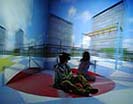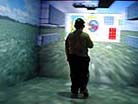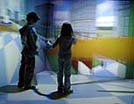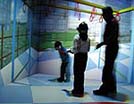|
Conditions
| condition |
activity |
interactivity |
immersion |
participants involved |
| interactive VR (IVR) |
active |
yes |
yes (VR cave) |
9♀, 8♂ |
| passive VR (PVR) |
passive |
watching an avatar interact |
yes (VR cave) |
5♀, 9♂ |
| control (LEGOs) |
active |
no |
no |
11♀, 8♂ |
| |
|
|
|
25♀, 25♂ = 50 total |
 experimental (VR) conditions: If assigned to an experimental group, the participant takes part in an activity in the virtual reality cave. In other words, the participant is immersed in a 3D re-construction of a playground in virtual reality (the Virtual Playground) and may be asked to design the playground in this 3D space. Two possibilities exist here, either: experimental (VR) conditions: If assigned to an experimental group, the participant takes part in an activity in the virtual reality cave. In other words, the participant is immersed in a 3D re-construction of a playground in virtual reality (the Virtual Playground) and may be asked to design the playground in this 3D space. Two possibilities exist here, either:
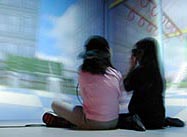 a) the participant is assigned to an “interactive VR” experience (IVR) where she actively designs the playground, having full control over the interactive features of the system or a) the participant is assigned to an “interactive VR” experience (IVR) where she actively designs the playground, having full control over the interactive features of the system or
b) the participant is assigned to a “passive VR” experience (PVR), where the re-design of the playground is played out as in a video without allowing the participant to act. In any case, the task is explained to the participant through a training environment, giving her a chance to practice moving objects around in the virtual space. Overall, the experimental tasks are similar to playing with a virtual construction kit (such as LEGO®) or a computer game but do not contain fast action or violence.
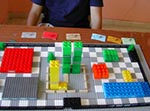  control condition: If assigned to the control group, the participant takes part in an activity using LEGO® bricks. The activity involves the design of a playground on a grid-like floor plan. The different coloured bricks represent the swings, slides, etc., which the participant must position in order to resize the areas that they cover according to the requirements/specifications provided. This group does not perform the task in a digital environment. Each participant is actively involved in designing the LEGO® playground; however no interactivity ("system" feedback) exists. control condition: If assigned to the control group, the participant takes part in an activity using LEGO® bricks. The activity involves the design of a playground on a grid-like floor plan. The different coloured bricks represent the swings, slides, etc., which the participant must position in order to resize the areas that they cover according to the requirements/specifications provided. This group does not perform the task in a digital environment. Each participant is actively involved in designing the LEGO® playground; however no interactivity ("system" feedback) exists.
|

